Did you know butternut squash is a tasty seasonal favorite? It’s also super nutritious, with over 400% of your daily vitamin A in just one cup. Its sweet, nutty taste and creamy texture make it a great addition to your meals.
In this guide, I’ll show you how to cook butternut squash perfectly. You’ll find easy recipes like roasted squash, creamy soups, and risottos. Plus, you’ll learn how to pick, prepare, and use butternut squash in your cooking. Let’s explore the world of butternut squash together!
Key Takeaways
- Butternut squash is a versatile ingredient packed with nutrients.
- Discover a variety of butternut squash recipes for every occasion.
- Learn essential tips on how to cook butternut squash like a pro.
- Explore easy butternut squash dishes that impress without the stress.
- Enhance your fall meals with creative uses for butternut squash.
What is Butternut Squash?
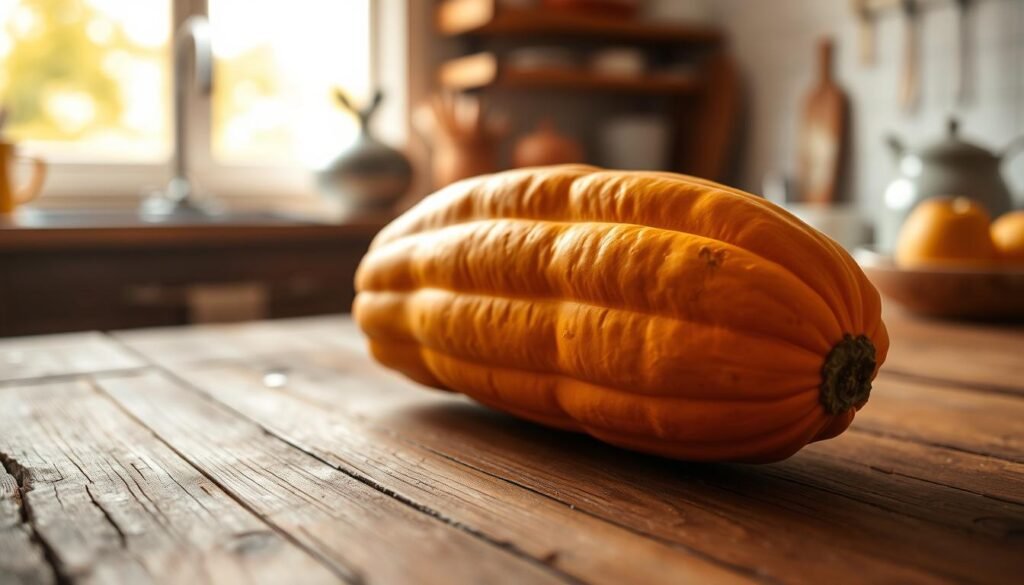
Butternut squash is a type of winter squash. It has a sweet and nutty taste. Its tan skin and orange flesh make it a tasty addition to many dishes.
Knowing what butternut squash is helps me see its value in cooking. I can use it roasted, mashed, or pureed.
Nutritional Benefits of Butternut Squash
Eating butternut squash is good for my health. It’s full of vitamins A, C, and E. These vitamins help my eyes, boost my immune system, and keep my heart healthy.
It also has a lot of fiber, which is great for digestion. Plus, it has potassium to help keep my blood pressure in check. Butternut squash is a key food for better nutrition.
Different Uses in Cooking
Butternut squash is versatile in cooking. I love roasting it to enhance its sweetness. It’s also great in soups for a creamy texture or blended into sauces.
It can turn salads into filling meals or be a tasty side dish. The possibilities are endless, and its flavor goes well with many recipes.
How to Choose the Right Butternut Squash
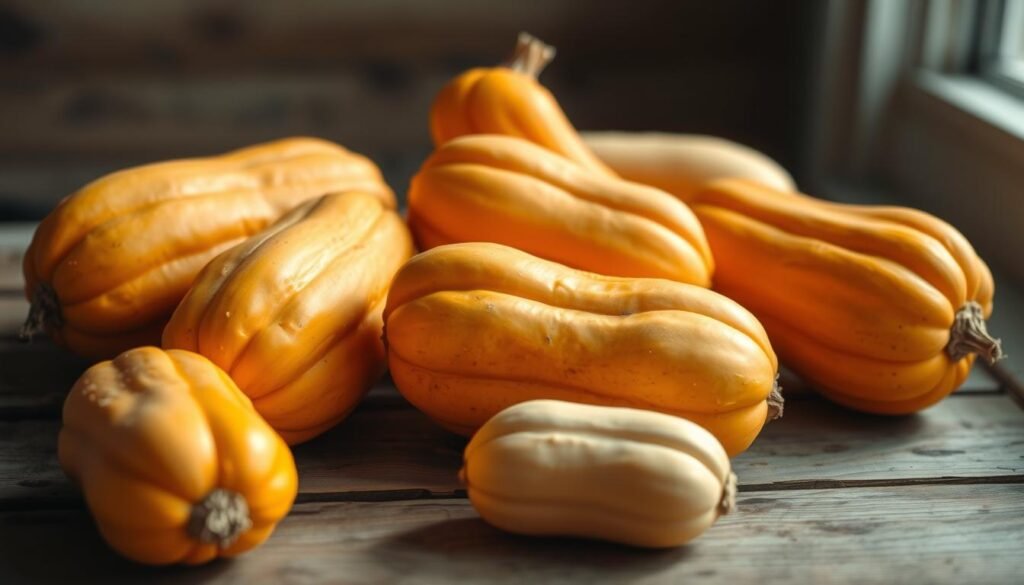
When I pick butternut squash, I look at a few key things. These factors affect the taste and texture of my meals. Choosing well makes my cooking better, giving me tasty and healthy dishes.
Size and Shape Considerations
Choosing butternut squash is more than just picking one. I check the size and shape. The best squash is firm, heavy, and has a smooth, tan skin.
A symmetrical, bulbous bottom means better quality inside. This is important for my favorite recipes.
Signs of Freshness
Knowing how to spot fresh butternut squash is important. I look for a hard shell without soft spots or blemishes. The squash’s vibrant skin color also shows it’s fresh.
These signs mean I’m getting a high-quality squash. It will make my dishes look and taste great.
Preparing Butternut Squash for Cooking
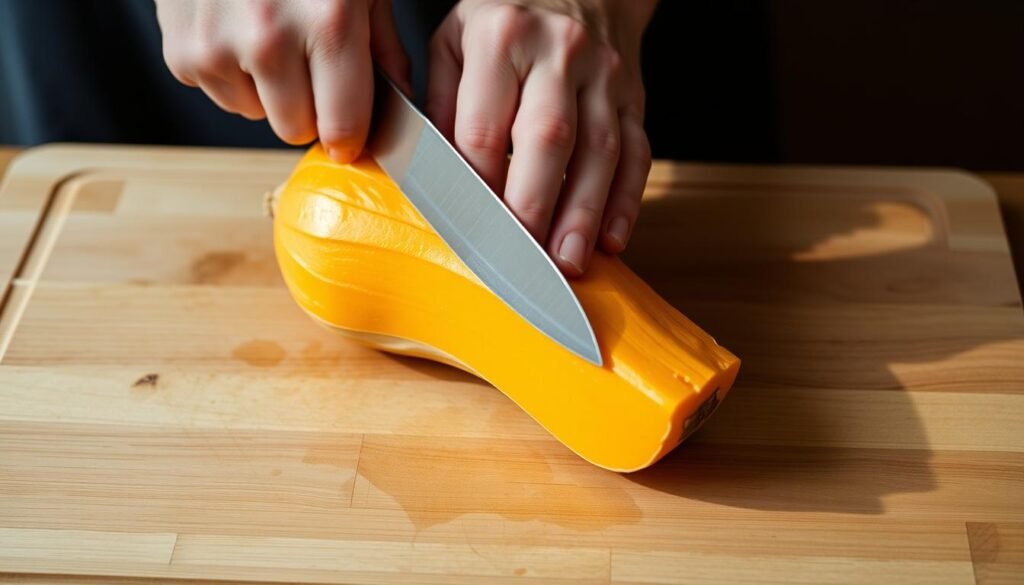
Preparing butternut squash is key to making great dishes. The right tools and peeling methods help me cook it perfectly. Let’s explore what I need to prepare this tasty vegetable.
Tools You’ll Need
First, I gather essential items for easy cooking. These tools for butternut squash include:
- Sharp vegetable peeler: For easily removing the tough skin.
- Sturdy chef’s knife: Ideal for cutting through the dense flesh.
- Cutting board: A stable surface to work on while peeling and cutting.
- Spoon: Perfect for scooping out seeds.
Step-by-Step Peeling Techniques
Now, I’m ready to peel the squash. Here’s how to do it effectively:
- Place the squash on a cutting board for stability.
- Using the vegetable peeler, start at the stem and make long, controlled strokes down to the base.
- Continue until all skin is removed, making sure to get rid of any tough patches.
Cutting and Dicing Tips
After peeling, I move on to cutting and dicing. Here’s how to cut it evenly:
- Carefully slice the squash in half lengthwise.
- Scoop out the seeds using a spoon.
- Position each half cut-side down, then slice into manageable sections.
- Lastly, dice the flesh into evenly-sized cubes for even cooking.
Cooking Methods for Butternut Squash
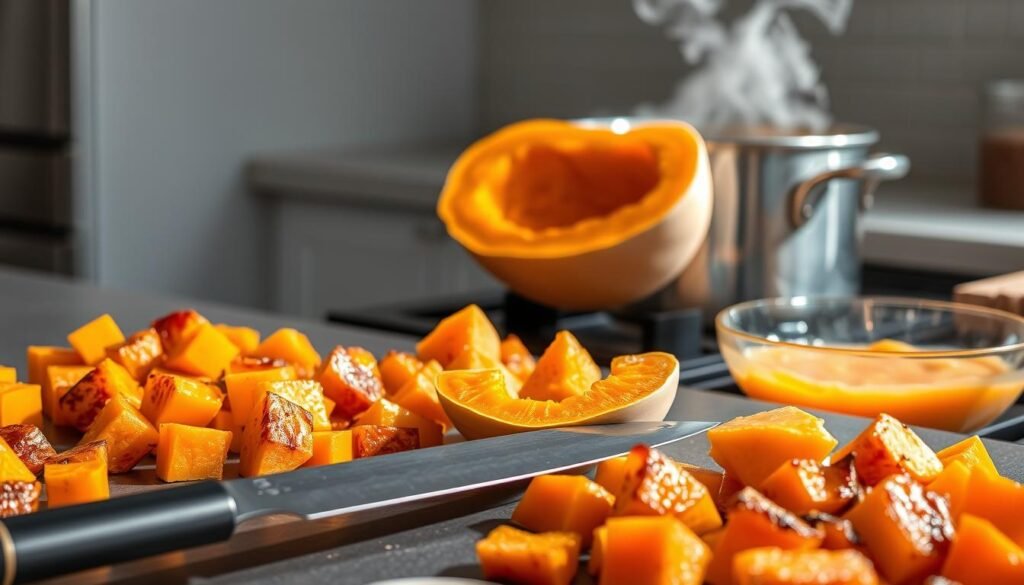
Exploring different cooking methods for butternut squash can make it a tasty addition to meals. I love trying out various techniques, each bringing its own flavor and texture. Here are some popular ways to cook butternut squash.
Roasting Butternut Squash
Roasting butternut squash is one of my top choices. It’s easy: I toss cubed squash in olive oil, add seasonings, and roast at 400°F for 30-35 minutes. This method boosts the flavor and adds a caramelized edge.
Steaming: A Healthier Option
For a healthier option, I steam butternut squash. Steaming keeps the squash tender and full of nutrients. I steam it for about 10 minutes, enjoying its light taste.
Boiling and Mashing Techniques
Boiling butternut squash is great for smooth purees or mash. I cut the squash into small pieces for even cooking. After boiling, I mash it for soups, sides, or as a recipe base.
Flavor Pairings for Butternut Squash
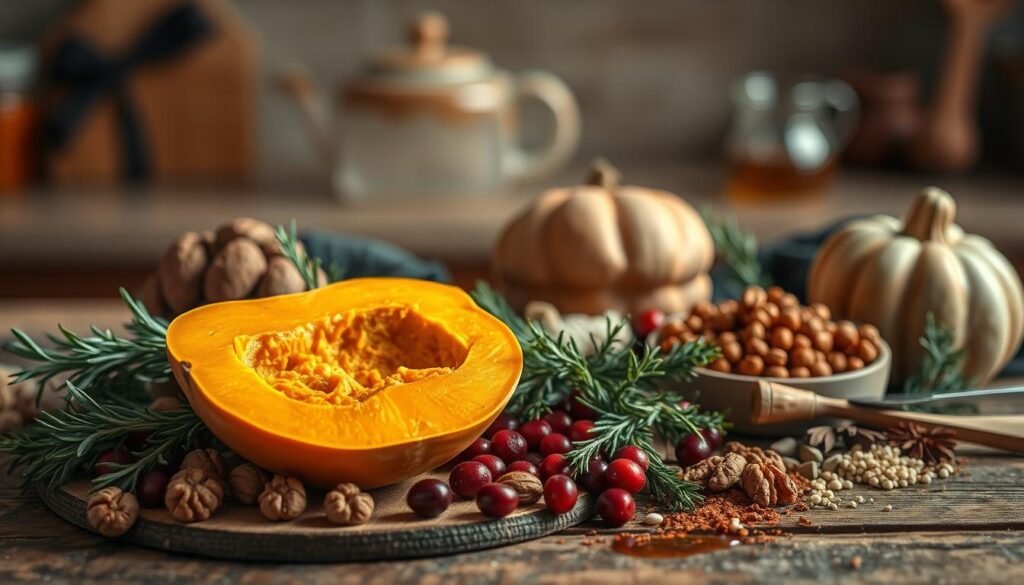
Butternut squash is amazing because it pairs well with many flavors. Its natural sweetness goes great with herbs and spices. This makes it perfect for simple or complex dishes.
Complementary Herbs and Spices
Rosemary and thyme are great with butternut squash, adding a deep aroma. Cinnamon and nutmeg add a warm sweetness that complements the squash. Garlic and onions enhance its earthy taste, making meals hearty.
Ginger adds excitement, and chili flakes bring a nice heat. These spices and herbs make the squash even more flavorful.
Ideas for Sweet and Savory Combinations
Butternut squash is versatile, perfect for sweet and savory dishes. Maple syrup or brown sugar on roasted squash is irresistible. Cheese like goat cheese or ricotta adds creaminess.
Balsamic vinegar or nuts like pecans or walnuts add crunch and complexity. For bold flavors, try curry spices. These pairings make any dish delicious.
Exploring these flavor pairings withbutternut squash ensures a tasty experience any time.
Simple Butternut Squash Recipes
Butternut squash is a versatile ingredient that I love to use, mainly in the fall. Its natural sweetness and creamy texture make it perfect for many dishes. Here are some easy butternut squash recipes, including roasted squash, a comforting soup, and creamy risotto.
Classic Roasted Butternut Squash
This roasted butternut squash recipe is a favorite of mine. I cube the squash, toss it with olive oil, salt, and cinnamon, then roast it until golden. This method brings out the squash’s natural sweetness and adds a satisfying texture. For a detailed guide on preparing the squash, check out this link.
Creamy Butternut Squash Soup
When I’m in the mood for something hearty and warming, I make butternut squash soup. I blend roasted squash with vegetable broth, cream, and spices for a silky and flavorful dish. It’s perfect with crusty bread for a cozy meal on a chilly day.
Butternut Squash Risotto
Butternut squash risotto is a filling and flavorful meal. I sauté Arborio rice with onions, add cubes of roasted squash, and stir in Parmesan cheese for creaminess. This dish is not only satisfying but also a beautiful addition to my dinner table.
Creative Ways to Use Butternut Squash
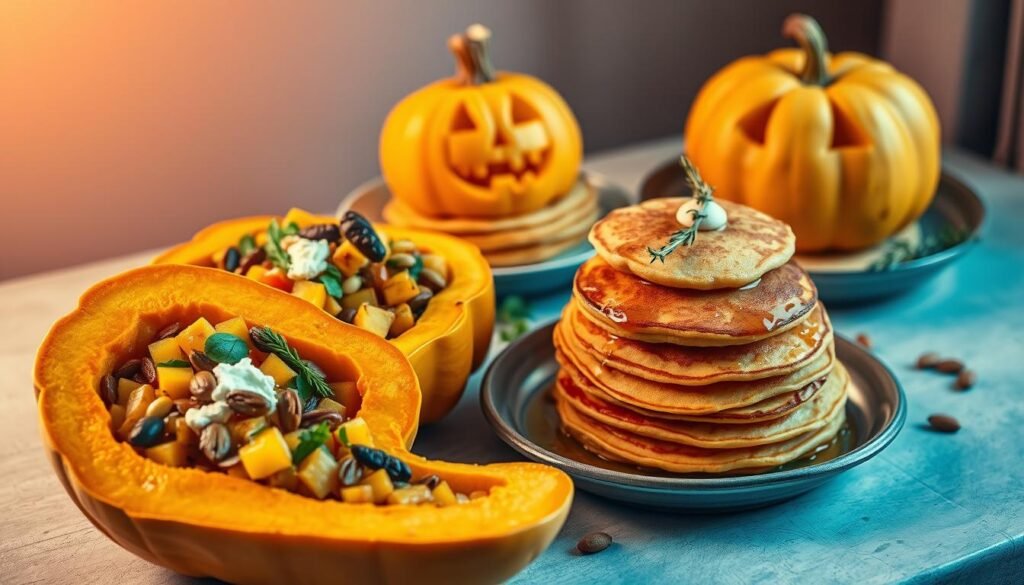
Butternut squash adds a unique flavor to many dishes. I love trying new ways to use it, like substituting it for common ingredients. This not only makes meals taste better but also adds nutrients.
Substituting in Traditional Dishes
I often swap butternut squash for potatoes in my favorite recipes. It’s great in tacos and enchiladas. The squash’s sweet and nutty taste gives these dishes a special flavor.
Butternut Squash in Salads
Adding butternut squash to salads is one of my top picks. Roasting it brings out its sweetness, perfect for butternut squash salad recipes. Its vibrant color and texture add to any salad, making it a great addition to both cold and warm quinoa salads.
Exploring creative uses for butternut squash opens up a world of recipes. It encourages me to be more creative with my meals. I think this squash should be in more dishes than it usually is!
Storing and Preserving Butternut Squash
Storing butternut squash right can keep it fresh for a long time. I keep mine in a cool, dark spot. This way, it stays good for weeks, letting me enjoy its taste.
If I’ve cooked some, I put leftovers in airtight containers. They stay fresh in the fridge for up to a week.
Best Practices for Freshness
I always pick whole squash with clean skins. After buying, I let it sit in the sun for 7 to 10 days. I turn it every few days.
To keep it safe, I clean it with vinegar or bleach. I check it weekly for dark spots or shriveling.
Freezing Butternut Squash
Freezing is great for keeping squash longer. Before freezing, I blanch it in boiling water. Then, I cool it down fast in ice water.
This keeps the nutrients and flavor in. It’s easy to enjoy squash even when it’s out of season. For more tips on storing butternut squash, check out this resource.
Tips for Cooking Butternut Squash with Kids
Turning cooking butternut squash into a family activity is easy. Just get kids involved in the kitchen. Fun cooking activities teach them skills and make it fun. Letting them shape the squash with cookie cutters adds a playful touch.
This encourages creativity and makes them feel like they own their meal.
Fun Cutting Shapes
Using cookie cutters to shape the squash makes cooking fun. Kids enjoy cutting and learn to use their hands better. It makes veggies more fun to eat.
Each shape adds color and excitement to our meals.
Involving Kids in Preparation
Getting kids to help with prep boosts their kitchen confidence. I make sure they’re safe while they help. They learn to wash, scoop, and season the squash.
They also learn about peeling and tossing with oil and spices. For more tips, check out this useful resource. It helps them enjoy flavors and appreciate healthy cooking.
FAQ
What is butternut squash and how is it different from other squashes?
Butternut squash is a winter squash known for its sweet taste and smooth skin. It’s denser than summer squashes because it’s picked when fully ripe. It’s great for both savory and sweet dishes and is very nutritious.
How do I peel and prepare butternut squash for cooking?
To peel it, use a sharp peeler starting at the stem. Cut it in half, remove the seeds, and dice it for even cooking.
What are the best cooking methods for butternut squash?
Roasting brings out its sweetness. Steaming is quicker and keeps nutrients. Boiling and mashing are good for soups and sides.
Which herbs and spices go well with butternut squash?
Rosemary, thyme, cinnamon, and nutmeg are great. Garlic and onions add depth. Maple syrup adds sweetness.
Can butternut squash be frozen, and if so, how?
Yes, it can be frozen. Blanch it first to keep its texture and taste. This way, you can enjoy it all year.
What are some creative ways to use butternut squash in my meals?
Use it instead of potatoes in mashes or casseroles. Add roasted squash to tacos or enchiladas. It’s also great in salads for flavor and color.
How can I involve my kids in cooking with butternut squash?
Make cooking fun for kids! Let them cut squash shapes or toss it with oil. Always supervise with knives. It’s a fun way to teach them about healthy eating.
